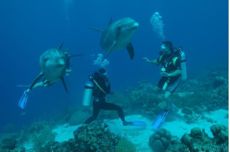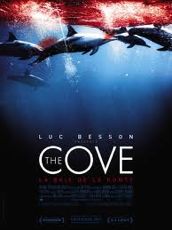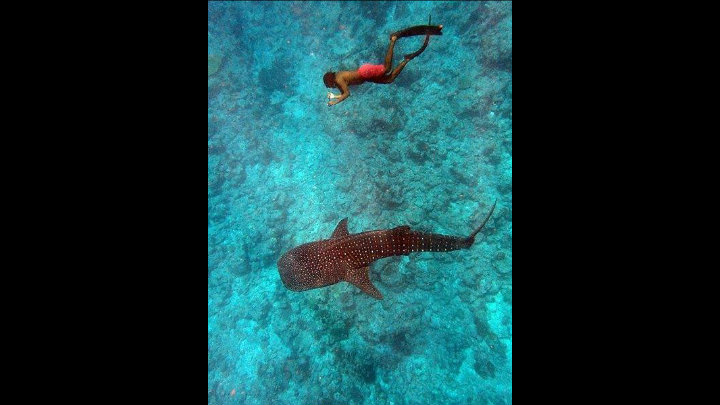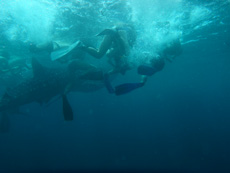The government’s decision to lease a lagoon to a dolphin habitation and family recreation project proposed by top tennis player Amir Mansoor will not force the marine creatures into captivity, and will support conservation efforts for one of the ocean’s most personable yet at-risk inhabitants.
On October 4, the Cabinet deliberated on a paper submitted by the Finance Ministry to lease a lagoon, location unspecified, for a dolphin habitation and training center.
While program specifics have not been officially released, an individual who has participated in such programs elsewhere and is familiar with the Maldives’ project informed Minivan News that the lagoon project is as much a conservation effort with educational motives as it is a recreational enterprise.
Correcting local media’s use of the word “trainer”, the source said the project will create “an open water program during which the dolphins will accompany the care takers on daily unstructured excursions,” and defined the role of caretaker as “taking a dog for a walk. This isn’t a Seaworld enterprise, with hoops and balls for public entertainment.”
While the lagoon program does not aim to put dolphins on display for commercial purposes, the source acknowledged that “it is an industry, you can’t deny that. People want to swim with dolphins. But this program is saying, ‘make it sensible.'”
Demonstrations will be offered but sources say they will be educational, not commercial.
“The demonstrations will show what dolphins are capable of, their speed, their use of eco-location, and other details. It will be fun, but education is the goal. Many people don’t know the basic facts of a dolphin’s lifestyle,” said source.
She added that reachout programs will be established with local public schools, handicapped organisations and orphanages.
The site is also being planned as “a place to spend the day,” featuring billiards, table tennis, photography, a restaurant, and play areas. With daily ferries from Male’, the cost will be friendly to locals.
“Above all, we’re trying to offer both locals and expatriates something to do. The dolphin program is a part of this larger recreational plan,” she summarized.
Freedom: the benchmark for success
The dolphin program includes two lagoons: a 1 kilometre living area surrounded by nets and allowing for free flow of water and fish, and a second, much larger area for excursions. The design is intended to simulate a natural habitat.
“The proposed lagoon is the largest for the small number of dolphins that will inhabit it in the world,” said one source. “It’s so spacious that if the dolphins don’t want to participate in an activity or hang around divers, they can just swim off. The philosophy is, ‘we’ll reward what you like, but you ignore what you don’t like’.”
The program follows a blueprint first attempted by the United States Navy in the 1960s. Since then, several conservation-based facilities have opened in the Caribbean with consistent levels of success.
Freedom is a critical benchmark: “Since the dolphins accompany trainers on daily excursions to the open ocean, it is clear to most people that the dolphins are free to leave or choose to return ‘home’,” said Director of Dolphins and Programs for the Curacao Dolphin Academy and President of the Southern Caribbean Cetacean Network (SCCN) George Kieffer.
Dolphins have allegedly exhibited natural behavior in these facilities including hunting, breeding and social ranking.
Though given the option to swim off, sources observe that dolphins willingly return to their enclosed living space when excursions are over. “They like to be intrigued and challenged, so the programs are always offering new exercises. If you were to put dolphins in a lagoon and just feed them, they would be very unhappy. As long as the challenges keep coming, the dolphins appear to be happy.”
“Make it sensible”
While some activists criticise any form of animal captivity, others suggest that open water programs are protecting the dolphin species.
Kieffer said programs similar to that proposed in the Maldives receive significantly less criticism than marine parks or inland aquariums, and nearly all negative claims have been “demonstrably untrue.”
“The success would appear to be measured by all three [existing facilities] having not only self-sustaining breeding populations, but increasing populations,” he said. As these populations surpass facility capacities, others such as the Maldives’ lagoon program are being endorsed.
“Once these animals have been bred and raised in open water programs, they can’t be released into the wild,” said a source familiar with the programs. “It’s better to find a way to keep them healthy. The program in the Maldives is good because these dolphins need a place to go.”
Rather than capture and train indigenous bottlenose dolphins, the Maldives’ lagoon program will import dolphins already bred in similar facilities. The bottlenose does well in human care, said Kieffer, preferring “small numbers within a social group and shallow water. [Maldives’] local dolphins such as the pan-tropical spotted dolphin and the spinner dolphin prefer deep water and hundreds of individuals within a large moving social group.”
Minivan asked Kieffer if the world’s oceans are safe for dolphins.
“Sadly no; they are vulnerable to the swift and diverse pressures human activities are placing on the sea. Dolphins and whales have endured over 50 million years of the ocean’s natural stresses and strains. And now in just the past several decades, our impact on the seas has rendered them fragile.
“Dolphins are a charismatic species that attracts human attention. The popularity of aquariums, zoos, and interactive programs highlights this point. When people have the opportunity to intimately view and interact with dolphins, they have the potential to form a cognitive and emotional connection – one that has the potential to arouse individuals to care for their new-found friends and become involved in marine causes.”
Local objections
Reports of the ‘dolphin lagoon’ were earlier published by local daily Haveeru. Individuals affiliated with the program said responses have not been positive.
Local dive magazine Scuba Tribe subsequently launched a campaign against the dolphin lagoon on social media outlets Facebook and Twitter.
Scuba Tribe’s argument begins by stating that “little is known how this project would proceed.”
“A training center for dolphins or a lagoon where tourists would come up to see them by paying a fee to see them is out of the question as they all can see them in the wild every single day. Local resorts and dive centers have regular dolphin watching cruises that happen on a daily basis,” reports the Scuba Tribe website.
A source familiar with diving practices in the Maldives claimed that many tour boats are not trained to approach dolphins, and that excessive diving in popular sites such as Hanifaru Bay has pushed fish populations away from these locations.
“Tourists can be seen jumping by the dozens into the water, pushing to see the  animals,” she said, noting that in August up to 17 boats could be seen at Hanifaru at one time. “This year was really disappointing for diving, because it was out of control. Why aren’t groups like Scuba Tribe worrying about this? Crowding on dive sites, disappearance of species like the whale shark from their favored areas, these are issues that are affecting the natural world and will soon affect the tourism industry as well. Everyone is involved.”
animals,” she said, noting that in August up to 17 boats could be seen at Hanifaru at one time. “This year was really disappointing for diving, because it was out of control. Why aren’t groups like Scuba Tribe worrying about this? Crowding on dive sites, disappearance of species like the whale shark from their favored areas, these are issues that are affecting the natural world and will soon affect the tourism industry as well. Everyone is involved.”
Hanifaru reef became a Marine Protected Area (MPA) in 2009 and a Core Area of the Biosphere Reserve after “intense tourism activities…threatened [the site’s] sustainability.” Activities are now subject to a site management plan.
Dolphins are most challenged by the impact of human activity in their habitat. Pollution, entanglement in fishing gear, collision with boats and unsafe fishing practices are a few examples. Whale and Dolphin Conservation Society cites coastal development, particularly for marine tourism, and chemical pollution as leading threats.
“Dolphins are also killed unintentionally in gill net, drift net, and purse-seine fishing practices around the world,” Kieffer said.
Purse seining, a fishing method whereby a vessel deploys an enormous net to encircle and capture entire schools of fish at once, “is very cost effective but indiscriminate, and generates a large amount of bycatch,” wrote Minivan News in a recent article. The practice is allegedly done in waters fringing on the Maldives’ national borders. “Nothing escapes,” Solah Mohamed, Head of Production for the Maldives’ Felivaru fish cannery, said of the practice.
Director of environmental NGO Bluepeace Ahmed Ikram said the NGO did not have a position on the lagoon program but was soliciting public opinion.
“We are aware of the project and are publicizing it through Facebook and Twitter to see what the public response is. Then we will analyze and discuss the results in the next week.”
Ikram said that the Maldives’ many environmentally-relevant projects has kept Blue Peace busy and made it difficult to focus on individual projects, such as the lagoon.
“This seems to be part of a progression of projects aimed at eco-tourism which do not quite live up to expectations,” he surmised. “It looks like everything is for sale, and most of it is for tourism.”
The downside of publicity
Publicity is a driving factor in Maldives tourism, however one source suggested that it can be too much.
“National Geographic did a report on Hanifaru Bay, and now tourists are all coming and saying, ‘We want to go to Hanifaru.’ As a result, it became a protected area. To protect the dive site, you have to control traffic.”
 In 2009, documentary film “The Cove” turned the international eye on Japan’s dolphin hunting culture and industry. Its implications for dolphin centers have proved damaging.
In 2009, documentary film “The Cove” turned the international eye on Japan’s dolphin hunting culture and industry. Its implications for dolphin centers have proved damaging.
According to the film, Japanese fishermen entrap dolphins and sell them to international buyers, some of whom work for marine entertainment organisations such as Seaworld. The remaining dolphins are slaughtered and sold as food, often labeled as fish or whale meat, “The Cove” website alleges.
Dolphin meat has been debated as unsafe for human consumption.
A source argues that the film’s implication that dolphin centers around the world cooperate with the Japanese industry is inaccurate and harmful to legitimate conservation programs.
“Dolphins which are exported or sold for business purposes go through very strict documentation procedures,” she said. “None of the parks in the US, Caribbean or Europe have dolphins that originated in Japan, and they have the proper paperwork to prove it.”
The source added that the film’s message has made dolphin program development more controversial. “If we did import dolphins from Japan, we would be accused of sustaining slaughter,” she said.
Minivan News subsequently learned that the Maldives’ lagoon dolphins will not come from Japan, and will be examined by American scientists to ensure that local wild dolphins are not negatively affected.
Avoiding the tourist trap
Keiffer shared his understanding of the Maldives’ facility with Minivan News: “From what I’ve learned, your local facility will not be a run-of-the-mill tourist trap looking to “cash-in” on dolphin popularity by any means necessary. On the contrary, I believe it is striving to be one of a very few organizations setting the standards by which dolphin display facilities are expected to meet if they truly intend to convey a sense of respect and appreciation for the animals under their care.”
He added that the facility’s success would demand caretakers be able to support the dolphins’ physical and emotional needs.
A local source compared the proposal to other operations. “Dolphins are in appalling conditions in some places. Aquariums, for instance – that’s a real cage. People should be opposing those. But this is a totally different ballgame.”
If approved by the government, the facility is expected to be completed by the end of 2012. An official title has not yet been selected.
Likes (0)Dislikes
(0)Dislikes (0)
(0)
 (0)Dislikes
(0)Dislikes (0)
(0)



